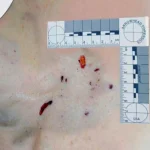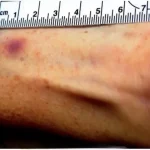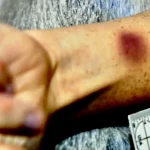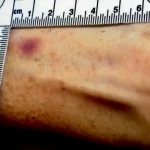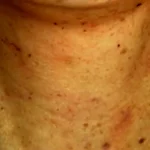Ellen Greenberg
Ellen Rae Greenberg, born on June 23, 1983, in New York City, was the only child of Joshua and Sandra Greenberg. 1994 The family moved to the Harrisburg from NY, Ellen attended Susquehanna Township Middle schools.
After graduating high school, Ellen Attended Pen State University. While at Penn State University, she worked as a “Lionizer,” where she introduced athletes and their parents to the campus and even helped out on the football field. Ellen graduated from Penn State with a degree in communications. She planned on becoming a speech pathologist, but realized it wasn’t the right career path for her. She then attended Temple University at night to earn her teaching credentials. After Ellen obtained her teaching credentials. Ellen began her career as a first-grade teacher at Juniata Park Academy.

Ellen Greenberg
Ellen Greenberg 1st Autopsy – Homicide
Based on his initial findings, Dr. Osbourne ruled the death a homicide.
January 27, 2011, at 9 a.m., The autopsy report of Ellen R. Greenberg, conducted by the Philadelphia Medical Examiner’s Office on January 27, 2011, lists the cause of death as multiple stab wounds and the manner of death as homicide.
Key Findings:
- Multiple stab wounds to the chest, abdomen, and back of the neck.
- An incised wound on the right occipital scalp.
- Injuries affecting major internal structures, including:
- Aortic arch
- Upper lobe of the left lung
- Liver
- Cervical spinal cord (C2-C3 level)
- Presence of bilateral hemothorax (blood in both chest cavities).
- Knife found embedded in the chest wound, with a blade length of 12.5 cm.
- Bruising (contusions) on the upper and lower extremities, indicating possible prior trauma.
Internal Examination:
- No fractures to the facial bones, clavicles, sternum, or pelvic bones.
- No injuries to the tongue or oral cavity, which might suggest a lack of defensive struggle.
- Normal heart and coronary arteries.
- Presence of subarachnoid hemorrhage over the cerebellar hemisphere and vermis.
- No fractures to the skull base or calvarium.
- No brain herniation.
Notable Observations:
- The depth and severity of the wounds, particularly those to the chest, neck, and spinal cord, would likely impair movement or self-inflicted repetition.
- The stab wounds to the back of the neck raise serious doubts about the possibility of suicide, as this location is difficult to reach.
- The original ruling of homicide contradicts the later reclassification to suicide, which has sparked controversy in the case. Second Autopsy
- Other Findings: Hemorrhaging in soft tissues.
Cause and Manner of Death: The autopsy concluded that the cause of death was multiple stab wounds, and the manner of death was initially classified as homicide.
Detailed Breakdown of Each Stab Wound from Ellen Greenberg’s Autopsy Report
The autopsy report documents 20 stab wounds across different regions of Ellen Greenberg’s chest, abdomen, neck, and scalp. Below is a stab wound-by-stab wound breakdown, categorized by location.
1. Chest Wounds
Stab Wound “A”
- Location: Midline of the chest, 30 cm below the top of the head.
- Size: 0.4 cm x 0.2 cm.
- Depth: 0.2 cm.
- Pathway: Front to back.
- Other Findings: Hemorrhaging in soft tissues.
Stab Wound “B”
- Location: Midline of the chest, 31 cm below the top of the head.
- Size: 0.3 cm x 0.3 cm.
- Depth: 0.2 cm.
- Pathway: Front to back.
- Other Findings: Hemorrhaging in soft tissues.
Stab Wound “C”
- Location: Right side of the chest, 29 cm below the top of the head, 4.5 cm to the right of midline.
- Size: 2 cm x 0.6 cm.
- Depth: 1.4 cm.
- Pathway: Slightly right to left, front to back, and slightly upward.
- Other Findings: Hemorrhaging in muscles of the right chest and beneath the right clavicle.
Stab Wound “D”
- Location: Right side of the chest, 33 cm below the top of the head, 2.7 cm to the right of midline.
- Size: 0.3 cm x 0.1 cm.
- Depth: 0.2 cm.
- Pathway: Front to back.
- Other Findings: Hemorrhaging in soft tissues.
Stab Wound “E”
- Location: Left side of the chest, 33 cm below the top of the head, 2.5 cm to the left of midline.
- Size: 1.7 cm x 0.5 cm.
- Depth: 10 cm.
- Pathway: Left to right, front to back, slightly downward.
- Other Findings:2.4 cm incision in aortic arch.
- Incision in upper lobe of left lung.
- 120 mL blood in pericardial sac.
- 600 mL of blood in left pleural cavity, 500 mL in right.
Stab Wound “F”
- Location: Midline of chest, 34.5 cm below the top of the head.
- Size: 0.6 cm x 0.2 cm.
- Depth: 0.2 cm.
- Pathway: Front to back.
- Other Findings: Hemorrhaging in soft tissues.
Stab Wound “G”
- Location: Midline of chest, 34.5 cm below the top of the head.
- Size: 0.6 cm x 0.2 cm.
- Depth: 0.2 cm.
- Pathway: Front to back.
- Other Findings: Hemorrhaging in soft tissues.
Stab Wound “H”
- Location: Midline of the chest, 42 cm below the top of the head.
- Size: 1.5 cm x 0.5 cm.
- Depth: 4 cm.
- Pathway: Slightly left to right, front to back.
- Other Findings:2.3 cm deep incision in liver.
- Internal bleeding in abdomen.
2. Abdominal Wound
Stab Wound “I”
- Location: Midline of abdomen, 46 cm below the top of the head.
- Size: 2 cm x 0.8 cm.
- Depth: 6 cm.
- Pathway: Slightly left to right, front to back.
- Other Findings: Hemorrhaging in abdominal muscles and internal bleeding.
3. Scalp Wound
Incised Wound “J”
- Location: Right occipital scalp, 8 cm above the right ear.
- Size: 6.5 cm x 1.1 cm.
- Depth: Through the skin and scalp.
- Pathway: Oblique orientation.
- Other Findings: Clean incised wound.
4. Neck Wounds
Stab Wound “K”
- Location: Posterior neck, 9 cm below the top of the head, 2 cm to the left of midline.
- Size: 2 cm x 0.2 cm.
- Depth: 0.3 cm.
- Pathway: Slightly left to right, back to front.
- Other Findings: Hemorrhaging in soft tissues.
Stab Wound “L”
- Location: Posterior neck, 14 cm below the top of the head, 4 cm to the left of midline.
- Size: 1.1 cm x 0.6 cm.
- Depth: 0.2 cm.
- Pathway: Slightly left to right, back to front.
- Other Findings: Hemorrhaging in soft tissues.
Stab Wound “M”
- Location: Midline of posterior neck, 11 cm below the top of the head.
- Size: 0.2 cm x 0.1 cm.
- Depth: 0.3 cm.
- Pathway: Back to front.
- Other Findings: Hemorrhaging in soft tissues.
Stab Wound “N”
- Location: Posterior neck, 13 cm below the top of the head, 0.5 cm to the left of midline.
- Size: 1.1 cm x 0.4 cm.
- Depth: 8 cm.
- Pathway: Left to right, back to front, slightly upward.
- Other Findings:Defect in ligamentum nuchae.
- Small vessel incision near cerebellum.
- Subarachnoid hemorrhage over cerebellum.
Stab Wound “O”
- Location: Posterior neck, 14 cm below the top of the head, 6.5 cm behind right ear.
- Size: 1.2 cm x 0.6 cm.
- Depth: 3 cm.
- Pathway: Right to left, back to front.
- Other Findings: Hemorrhaging in soft tissues.
Stab Wound “P”
- Location: Posterior neck, 13.5 cm below the top of the head, 2 cm to the right of midline.
- Size: 1 cm x 0.3 cm.
- Depth: 2.1 cm.
- Pathway: Right to left, back to front.
- Other Findings: Hemorrhaging in soft tissues.
Stab Wound “Q”
- Location: Posterior neck, 15 cm below the top of the head, 3 cm to the left of midline.
- Size: 0.6 cm x 0.3 cm.
- Depth: 2 cm.
- Pathway: Slightly left to right, back to front.
- Other Findings: Hemorrhaging in soft tissues.
Stab Wound “R”
- Location: Posterior neck, 16 cm below the top of the head, 3 cm to the left of midline.
- Size: 0.9 cm x 0.6 cm.
- Depth: 1.9 cm.
- Pathway: Slightly left to right, back to front.
- Other Findings: Hemorrhaging in soft tissues.
Key Takeaways
- 20 stab wounds across chest, abdomen, neck, and scalp.
- Several deep wounds penetrating major organs.
- Multiple neck wounds, some near the spinal cord and brainstem.
- Bruises on arms and legs suggestive of prior trauma.
Dr. Osbourne ruled the death a homicide.
Dr. Osborne ruled the death a suicide
Ellen Greenberg Injuries – Bruises
A pathologist at the medical examiner’s office noted multiple bruises while performing Ellen Greenberg’s autopsy. Later, after reviewing the photos, an outside pathologist working with the Greenberg family wrote that the bruises “were consistent with a repeated beating.” Ellen Greenberg had 20 knife wounds and at least 11 bruises. Authorities said she killed herself
- Ellen R Greenberg Bruises. Her autopsy reportedly noted 11 bruises
Ellen Greenberg
2012 Dr. Cyril Wecht Findings
Dr. Cyril Wecht’s Independent suicide
January 11. 2012 report by Dr. Cyril Wecht, a renowned forensic pathologist, concerning the death of Ellen Greenberg. Dr. Wecht was commissioned by Greenberg’s family to conduct an independent review following
the controversial ruling of her death as a suicide.
- Ellen’s parents hired Dr. Cyril Wecht, a forensic pathologist, to conduct an independent autopsy review.
- Dr. Wecht’s Key Findings:
- Unusual Nature of Stab Wounds:
- 20 stab wounds (including deep neck and back injuries) are highly inconsistent with suicide.
- Lack of Defensive Wounds:
- While Ellen had no clear defensive wounds, Dr. Wecht argues this does not prove suicide, as she could have been incapacitated early in an attack.
- Concerns Over Crime Scene Handling:
- The apartment was cleaned too soon, and key evidence may have been lost.
- Suspicious Nature of Injuries:
- Stab wounds to the back and neck raise doubts about whether she could have inflicted them herself.
Key Observations from Dr. Wecht’s Report:
- Multiple Stab Wounds: Dr. Wecht emphasized the unusual nature of the case, noting that Ellen sustained 20 stab wounds, including injuries to her chest, abdomen, and back of the neck. He highlighted that suicidal stab wounds are rarely multiple and that stab wounds to the back are particularly uncommon in suicide cases.
- Lack of Defensive Wounds: The report acknowledged the absence of defensive wounds on Ellen’s body. However, Dr. Wecht suggested that this does not conclusively indicate suicide, as the absence could be due to a “blitz” attack, where the victim is overwhelmed quickly and unable to defend herself.
- Scene Investigation: Dr. Wecht raised concerns about the crime scene management, noting that the apartment was cleaned before a thorough forensic examination could be conducted. He also pointed out that key items, such as Ellen’s personal electronics, were removed from the scene prematurely.
- Conclusion: Dr. Wecht concluded that the manner of Ellen Greenberg’s death is “strongly suspicious of homicide.” He recommended a comprehensive re-investigation, including a thorough review of all forensic evidence and witness statements.
Ellen Greenberg – Autopsy Reconstructed 3D Computer Model
- 3-dimensional female model was created based on the measurements in autopsy report
- The 3D model was brought into 3D editing software
- Cameras were placed in 3D space to match the autopsy photographs
- The exchangeable image file format (EXIF) data from the digital autopsy photographs were used to set the focal length of the computer cameras
- A computer generated 3D ruler was created based on the ruler evident in the autopsy photographs
- The 3D ruler was positioned in several of the camera views to match the autopsy photographs and confirm the scale
- The autopsy photographs were used to position the wounds and bruises on the 3D model
ELLEN GREENBERG INJURIES
- Ellen R Greenberg Autopsy Computer Model Right Anatomy with Knives
- Ellen R Greenberg Autopsy Computer Model Right Anatomy with Knives
- Ellen R Greenberg Autopsy Computer Model Neck
- Ellen R Greenberg Autopsy Computer Model Head
- Ellen R Greenberg Autopsy Computer Model Chest
- Ellen R Greenberg Autopsy Computer Model Front Body
- Ellen R Greenberg Autopsy Computer Model Front Anatomy with Knives
- Ellen R Greenberg Autopsy Computer Model Back Anatomy with Knives
- Ellen R Greenberg Autopsy Computer Model Neck Anatomy with Knives
- Ellen R Greenberg Autopsy Computer Model Neck Anatomy with Knives
- Ellen R Greenberg Autopsy Computer Model Chest Anatomy with Knives
- Ellen R Greenberg Autopsy Computer Model Neck Anatomy with Knives
- Ellen R Greenberg Autopsy Computer Model Neck and Chest Anatomy with Knives
- Ellen R Greenberg Autopsy Computer Model Neck and Chest Anatomy with Knives
January 07, 2020
Order
January 27, 2020
Medical Examine Osborne Answers
